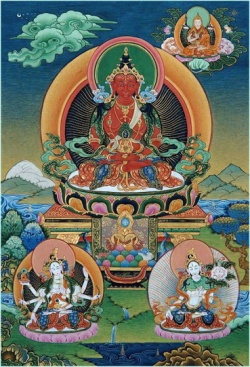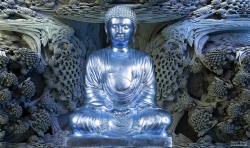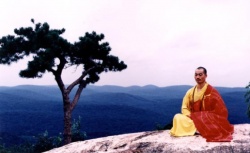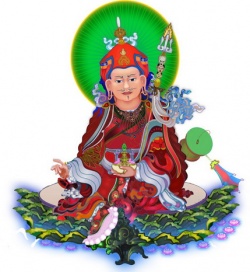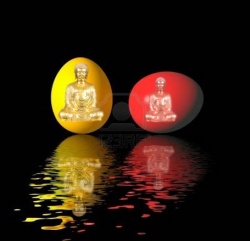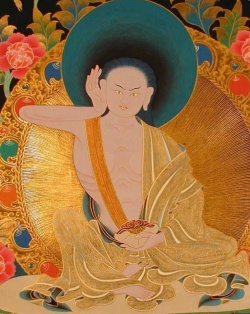Yidam practice
“Wrathful practice” is an approach within Tantric Buddhism that can dramatically accelerate your progress. However, it is only workable if you are willing to have Buddhist practice be the sole important thing in your life, under close supervision of a lama, after many years of preliminary practice. And, it comes with a steep price, and a serious risk.
Tantric Buddhism is the path of transformation. The practices of Tantra transform negative emotions into positive, enlightened ones. Usually in Tantra we wait for negative emotions to occur, and then apply trans-formative methods. If you are sufficiently committed, however, you can deliberately stir up negative emotions in order to transform them. This makes it possible to practice transformation as much as you want—rather than having to wait around for something bad to happen.
The most negative emotion is hatred. Wrathful practice is called “wrathful” because hatred is the emotion you most stir up and attempt to transform. As part of the method, you rely on a “wrathful yidam,” or visualized enraged deity. (Dorje Phurba, shown at the top of this page, is an example.) With this practice, hatred can be transformed into the clarity of enlightenment.
According to Tibetan Buddhism, destruction is one of the four functions of a Buddha. Wrathful practice gives you the clarity to know what must be destroyed, and the ferocity to destroy it.
Generally, Buddhist practice makes your life work better—and for many of us, that is the main motivation. Wrathful practice is likely to make your life worse—at least for several years. Part of the wrathful method is to abandon, or even actively destroy, any aspect of your life that interferes with your practice. Everything in life except practice can fall apart. That is what I called the “steep price.”
The “serious risk” is that you will fail in the transformation—and fail to see that you have failed. This danger is spoken of frequently in Tibetan texts—and this outcome is common. Wrathful yidam practice can produce extraordinary arrogance. That is based on the perception that “I have transformed myself into an enlightened, wrathful being.” (Properly, yidam practice is the perception that “the yidam is occurring.” It is non-personal.)
It is easy to persuade yourself that you have succeeded when you have not. Then you believe you have complete, clear understanding of Buddhism, you are qualified to say who or what needs to be destroyed, and you are just the one to do it. That makes you dangerous to others.
===Yidam Practice===
Yutang Lin
Disciple Jing Xing asked me to write an article on "How to Practice in the Dharma Gate of Kurukulla." I replied, saying that it is enough to repeat Kurukulla's Heart Mantra and practice according to the Kurukulla Unification Sadhana. In association with this request and response, I am setting out below the key points in Yidam practices.
Our time and energies are both very limited; therefore, it is most appropriate for us to adopt one particular Dharma practice and then delve into it. Thus, through the strength of familiarity, it would be easier to attain realizations.
Our habitual grasping to self-centeredness is heavy and deep; therefore, Tantra teaches Yidam practice.
On the one hand it is still following our habit of grasping, and yet, on the other hand, as visualization of Yidam grows into maturity it will gradually replace our grasping to the self of a worldling.
Fundamentally, we still need, first of all, to comprehend the meaning of Blank Essence and Causal Origination, and to develop genuine Bodhi aspiration that dedicates oneself to the practice and propagation of the Dharma so as to help all sentient beings to attain full enlightenment sooner.
Only by living a life in accordance with Dharma and its practices can one gradually forget the previous self-centered personality, and constantly sustain the identification with the Yidam so as to render all thoughts, speeches and activities in accord with enlightened attitudes.
Set up Yidam's image or statue, and make offerings and prostrations to the Yidam. Thus one's relationships with the Yidam will become more and more intimate day by day.
Print Yidam's images, mantra wheel, Sadhanas, etc., for free distribution. Thus one's causal connections with this particular Dharma Gate will daily become deeper and closer.
Follow senior or realized practitioners of the particular Dharma Gate to receive their teachings and blessings through attending them in daily life.
If one practices as mentioned above, then one will have a better opportunity to attain realization. May those dedicate themselves to Yidam practices take heed and strive accordingly!
Advice on Yidam Practice
by Khenpo Shenga
At times, chant the mantra while experiencing naturally arising rigpa, a state of wholeness, beyond change or fluctuation, in which all that appears and exists is equality, the pure realm of the dharmakāya.
At times, consider that the lama arises in the form of the yidam. In the confident assurance that the mandala, which is the great display of the Awesome Heruka, is, and always has been, spontaneously perfect, combine deity, mantra and reality itself. Through this, all that appears, all sounds and all thoughts arise as the naturally appearing pure realm of the wrathful deity.
At times, enhance the strength of your practice by meditating on referenceless and unbiased compassion.
Fulfill your commitments by offering tsok and tormas on auspicious days. Make offerings and recite praises to the dharmapālas regularly, and generate heartfelt commitment to the teachings and beings.
Take the oath-bound deities as your servants,
Assign tasks to the gods and demons of phenomenal existence,
Experience both happiness and suffering as the great equalness of single taste,
And blend all changing experience with the dharmakāya.
“I am the great and glorious Heruka!
My food is the life-force of living beings,
My seat, the three worlds and three planes of existence.
I am the Lama. I am the Yidam.
I am Samantabhadra, the mighty Vajradhāra.
Without me, in the time before me,
There was no saṃsāra, no transcendence.
Now, the phenomena of saṃsāra and nirvāṇa
Are all perfect within me, the great Heruka.
The blazing fire mountain is my realm.
The vīras and ḍākinīs are my retinue.
The Great Perfection is my Dharma.
I am the Heruka of equalness and perfection.”
At all times, such pride is necessary.
By Shenphenpa (Khenpo Shenga).
| Translated by Adam Pearcey, Rigpa Translations, 2013.
